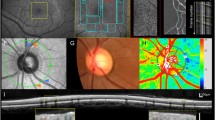Abstract
• Background: It has been reported that scleral buckling reduces the blood flow velocity in retinal vessels. Blood flow changes may also appear in other ocular and extraocular vessels. This study describes the blood flow velocity changes in the ophthalmic artery (OA) after performing this procedure. • Methods: The study was carried out in 12 patients (12 eyes) with rhegmatogenous retinal detachment. Color Doppler imaging was used to measure the peak and average blood flow velocity in the OA. Measurements were taken 1 day before and 2 days after scleral buckling surgery was performed. Intraocular pressure (10P) was measured prior to each ultrasound study. • Results: We found that statistically significant reductions in the peak flow velocity (33%) and average flow velocity (31%) occur in the OA after scleral buckling. All patients showed an increase in IOP after surgery. • Conclusion: Buckling surgery reduces the blood flow velocity in the OA. Since the OA is the origin of the arterial branches that supply blood to the eye, our results suggest that scleral buckling may decrease not only retinal but also choroidal blood perfusion. Some extraocular structures might also be affected.
Similar content being viewed by others
References
Boniuk M, Zimmerman LE (1961) Necrosis of uvea, sclera, and retina following operations for retinal detachment. Arch Ophthalmol 66:318–326
Cohen S, Kremer I, Yassur Y, BenSira I (1988) Peripheral retinal neovascularization and rubeosis iridis after a bilateral circular buckling operation. Ann Ophthalmol 20:153–156
Diddie KR, Ernest JT (1980) Uveal flow after 360° constriction in the rabbit. Arch Ophthalmol 98:729–730
Dobbie JG (1980) Circulatory changes in the eye associated to retinal detachment and its repair. Soc 78:503–566
Duncan WJ (1988) Color Doppler in clinical cardiology. Saunders, Philadelphia
Erickson SJ, Hendrix LE, Massaro BM, Harris GJ, Lewandowski MF, Foley WD, Lawson TL (1989) Color Doppler flow imaging of the normal and abnormal orbit. Radiology 173:511–516
Erickson SJ, Mewissen MW, Foley WD, Lawson T, Middleton WD, Lipchik EO, Quiroz FA, Macrander SJ (1989) Color Doppler evaluation of arterial stenoses and occlusions involving the neck and thoracic inlet. Radiographics 9:389–406
Erickson SJ, Mewissen MW, Foley WD, Lawson TL, Middleton WD, Quiroz FA, Macrander SJ, Lipchik EO (1989) Stenoses of the internal carotid artery: assessment using color Doppler imaging compared with angiography. Am J Roentgenol 152:1299–1305
Flaharty PM, Lieb WE, Sergott RC, Bosley TM, Savino PJ (1991) Color Doppler imaging. A new noninvasive technique to diagnose and monitor carotid cavernous sinus fistulas. Arch Ophthalmol 109:522–526
Foulds WS, Reid H, Chrisholm IA (1974) Factors influencing visual recovery after retinal detachment surgery. Mod Probl Ophthalmol 12:49–57
Gardner TW, Quillen DA, Blankenship GW, Marshall WK (1993) Intraocular pressure fluctuations during scleral buckling surgery. Ophthalmol 100:1050–1054
Ho AC, Lieb WE, Flaharty PM, Sergott RC, Brown GC, Bosley TM, Savino PJ (1992) Color doppler imaging of the ocular ischemic syndrome. Ophthalmol 99:1453–1462
Jarret WH, Brockhurst RJ (1965) Unexplained blindness and optic atrophy following retinal detachment surgery. Arch. Ophthalmol 73:782–791
Lieb WE, Cohen SM, Merton DA, Shields JA, Mitchell DG, Goldberg BB (1991) Color Doppler imaging of the eye and orbit. Technique and normal vascular anatomy. Arch Ophthalmol 109:527–531
Ogasawara H; Feke GT, Yoshida A, Milbocker MT, Weiter JJ, McMeel JW (1992) Retinal blood flow alterations associated with scleral buckling and encircling procedures. Br J Ophthalmol 76:275–279
Regillo CD, Sergott RC, Brown GC (1993) Successful scleral buckling procedures decrease central retinal artery blood flow velocity. Ophthalmology 100:1044–1049
Robertson DM (1975) Anterior segment ischemia after segmental episcleral buckling and cryopexy. Am J Ophthalmol 79:871–874
Rojanapongpun P, Drance SM (1993) Velocity of ophthalmic arterial flow recorded by Doppler ultrasound in normal subjects. Am J Ophthalmol 115:174–180
Scoutt LM, Zawin ML, Taylor KJW (1990) Doppler ultrasound. 11. Clinical applications. Radiology 174:309–319
Taylor KJW, Holland S (1990) Doppler ultrasound. 1. Basic principles, instrumentation, and pitfalls. Radiology 174:297–307
Author information
Authors and Affiliations
Rights and permissions
About this article
Cite this article
Santos, L., Capeans, C., Gonzalez, F. et al. Ocular blood flow velocity reduction after buckling surgery. Graefe's Arch Clin Exp Ophthalmol 232, 666–669 (1994). https://doi.org/10.1007/BF00171381
Received:
Revised:
Accepted:
Issue Date:
DOI: https://doi.org/10.1007/BF00171381




